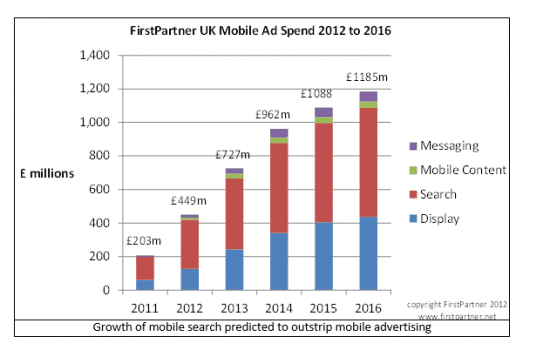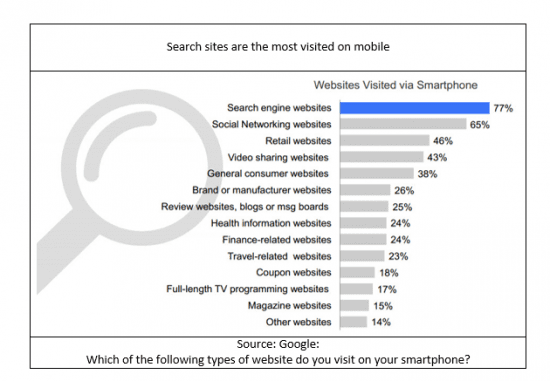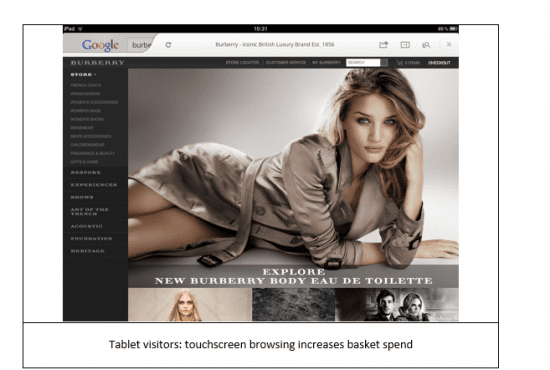Maximise Google to improve your mobile search
'Truly great search is all about turning intentions into actions, lightning fast. In the early days of Google, users would type in a query, we’d return ten blue links, and they’d move on happy', says Google in its AdWords blog.
That’s not enough today’s mobile users. 50% of mobile interactions start with a search, and users want more from that search.
'When searching for great local restaurants, they want places to eat right there on the results page, not another click or two away. It’s the same with hotels, flight options, directions and shopping', the blog continues.
Google, a self-proclaimed ‘mobile first’ company, has invested heavily in technology, slick marketing and an extensive suite of search tools to drive consumer demand and assist marketers in taking advantage of the opportunity to delivered personalised, time and location sensitive results.
Google estimates that mobile search is growing 8 times faster than PC search, and has grown 500% in the past 2 years. Mobile search growth is projected to out-strip mobile display advertising for the foreseeable future.

It would not be reasonable to attribute 100% of the Mobile search business to Google, since Bing and Yahoo! deliver competing mobile search platforms. But let’s not underestimate the role Google has played in defining the mobile search market, and its impact in realising one of mobile marketing’s greatest consumer and business achievements through its proprietary products and service, notably:
- Android, its open-source Android operating system, which now attracts over 1 million new customers daily, and is the clear market leader.
- Search tools: including the Google mobile browsing widget which combines text, voice and visual search functionality (particularly relevant for location-based searches).
- Insights and intelligence: watch out for The Mobile playbook, Our Mobile Planet, the 'Small screen, big opportunity' ads blog.

5 tips to getting the most from mobile search
1. Start by reviewing search behaviour
As with so many other aspects of marketing our advice is to start by reviewing people’s search activity and the volume of demand. Google’s free Keyword Tool used to let you assess the number of searches by entering a phrase and then choose ‘mobile’ against ‘desktop’ volumes in the box 'Show ideas and statistics for'. The new Keyword Planner is reputed to have this feature incorporated soon.
Don’t forget to set a Match Type, where you can limit searches to those including the word in a Phrase or an Exact Match.
It’s worth researching how behaviour varies through the day. There are variations by day part which will impact how and where you should allocate your mobile search budget
The IAB’s study into connected device usage highlights that all three screens (desktop, tablet and mobile) complement each other. The three screens allow for constant connectivity in and out of home, in the evenings and weekends. Mobile can be used most effectively in driving enquiries, via search working alongside banner ads or in-app push notifications, to deliver product information.
2. Making sure your mobile site is optimised for SEO
As with desktop search, the majority of searchers still click on the natural or organic listing, so it’s important to maximize your visibility here.
Gaining good visibility in the natural listings on mobile relies on solid SEO principles that you will be familiar with, which rely on a similar algorithm to desktop search, but there are some key features to gain visibility.
Keyword targeting
To adapt for mobile users’ task-oriented behaviour, brands should identify and prioritise the search terms used most commonly on mobile, including ‘deals, offers, sales’ with a local qualifier appearing frequently.
Crawlability
Consider how search engine crawlers function, and optimise your visibility. If you have a mobile-specific site with dedicated content then you should create mobile site specific site maps. But if you’re using a design technique like progressive enhancement aka responsive web design with common content for all screen resolutions then this isn’t necessary.
Optimise UX
Mobile users want ease, speed, and a frictionless user experience. Always try to reduce load times by optimizing content, images and code.
Google recommends page load times less than 5 seconds and can penalize slower sites.
You can gain an idea of how Google evaluates your site using the 'Test Your Site' on Google Get Mo
3. In-home: cater for high-spending tablet users
The IAB’s research highlights that most people with Tablets are dual screening, with 51% of all Tablet usage occurring in front of the TV.
Tablet owners are 50% more likely to use their tablet to dual screen than their mobile (35%) or their PC (33%).
Touchscreens have changed the way consumers seek product information. Tablet users claim to spend over 4 hours shopping on their devices each week, with 43% saying they prefer search on tablet compared with PC or mobile.
This can be explained by the superior browsing experience, the touchscreen interface, the location and mindset of tablet usage, where browsing is a more relaxed, less time pressured 'lean-back' experience than PC browsing allows.
Critically, tablet browsers also tend to spend more. Based on its analysis of 16.3 billion visits to websites of more than 150 retailers, Adobe Digital Marketing Insights revealed that tablet visitors spend over 50% more per purchase than smartphone visitors, and over 20% more than ‘traditional’ visitors using desktop PCs.

Marketers can use the search targeting capabilities of AdWords to reach tablet users during the evening, and drive them to tablet-oriented landing pages to maximize engagement and conversion. Unfortunately, with Google's Enhanced campaigns, it's now more difficult to target tablet users than previously.
- Point ads and ad extensions (on Search) to tablet focused landing pages
- Designate separate budgets for tablet campaigns. In search campaigns: bid for 1st-3rd position above the fold
- State a clear value proposition for tablet customers in your ad creative, such as 'view our selection of iPad cases today!'
- Day-part campaigns to match when consumers are using tablets (evenings, weekends).
- Review Google Analytics for tablet traffic patterns, and allocate bids and budgets based on peak times.
- Leverage large, touch friendly screens! Utilize new tablet rich media ad units in your campaigns.
4. On-the-move: delivers geo-location based results
Geo-targeting is one of the greatest differences between desktop and mobile search and one of the greatest opportunities. 85 per cent of mobile search has a local intent, says Google, and 81% of searchers act upon the patient based information they find. This explains why the retail, travel and entertainment top the list for most popular search queries.
Your search returns should match shoppers’ demands for quick, easy, simple responses to task-oriented searches. Typically they enter no more than two to three words per query, and want to find directions to your address (with zip code), a link to a your (mobile-optimised) site, and button to call your number (with correct dialing code).
5. PPC on mobile: bid aggressively
Space constraints on a mobile screen mean paid ads are more prominent relative to natural search returns, with two paid ads appearing on the top and three on the bottom.
Google Adwords enables specific targeting of mobile searchers which is not possible in natural search, so even if you don’t advertise in Adwords for desktop searches you should consider how you can target mobile searchers. More limited inventory and specific targeting options may make it worthwhile to bid higher on mobile, although many compilations show that mobile CPC are currently lower than desktop CPC.
Be prepared to bid 2x higher to get on the first page of search results. You will be competing to have your ad served on 5 ad spots vs 10 for desktop, and add a click-to-call feature when possible.
Select mobile ad formats to meet user demand
Google Adwords isn’t just about text ads and blue links, you can choose a number of ad extensions to provide the most useful search returns. These include:
- Click to Call - Extend my ads with a phone number
Click to Call is one of the most effective ways to connect to your consumers. We have seen URLs CTR increase by 30% by using the CTC feature. Google AdWord’s ‘Call Extensions’ and Bing adCentre’s Click-to-Call drive call traffic directly for search results. In addition to click-to-call functionality, retailers can also give mobile users the option to click through to the website.
- Location - Extend my ads with location information
Location presents a significant opportunity for retailers aiming to drive footfall who should use location extensions to promote local details within Google Places and adCenter, which should result in a reallocation of retailers’ mobile search budgets in today’s cut-throat business climate.
- Sitelinks - Extend my ads with links to sections on my site
Site links are an effective way for brands to provide mobile users with additional options or offers to direct their click into site. This option would take more real estate on the site results page, thereby increasing the chance of click through.
- Mobile App - Extend my ads with a link to a mobile/tablet app
For retailers with apps to promote, Google’s click-to-download feature allows you to download links to iTunes or Google Play. Handset detection software plays a critical role here, filtering iOS / Android traffic to the right appstore automatically. Users simply click the link for the correct app, which elegantly sidesteps the major challenge of saving a timely trawl through the 500,000 apps in each appstore
Case study on Roys Restaurant
After realizing that mobile traffic was outperforming desktop traffic in CTR and CPCs, Roy’s Restaurants created a separate mobile-only campaign to maximize number of calls and clicks.
The search solution was based on hyperlocal location extensions to better target on-the-go customers searching nearby one of their local restaurants.
'Mobile searchers looking for dining options could effortlessly see how close they were to a nearby Roy's Restaurant and the click to call function allowed for instant reservations. Our hyperlocal mobile-only campaign drove a 40% increase in calls with a CPC 67% less than desktop ads. The numbers are impossible to ignore. We have to invest in hyperlocal mobile advertising as part of our long-term growth strategy'. Jason Maloney, Vice President of Marketing for Roy’s.
Results
- Achieved 800% ROI on mobile-only campaigns.
- Drove 40% more calls.
- Hyperlocal mobile ads had a 539% higher CTR and 67% cheaper CPC compared to previous desktop campaigns.







